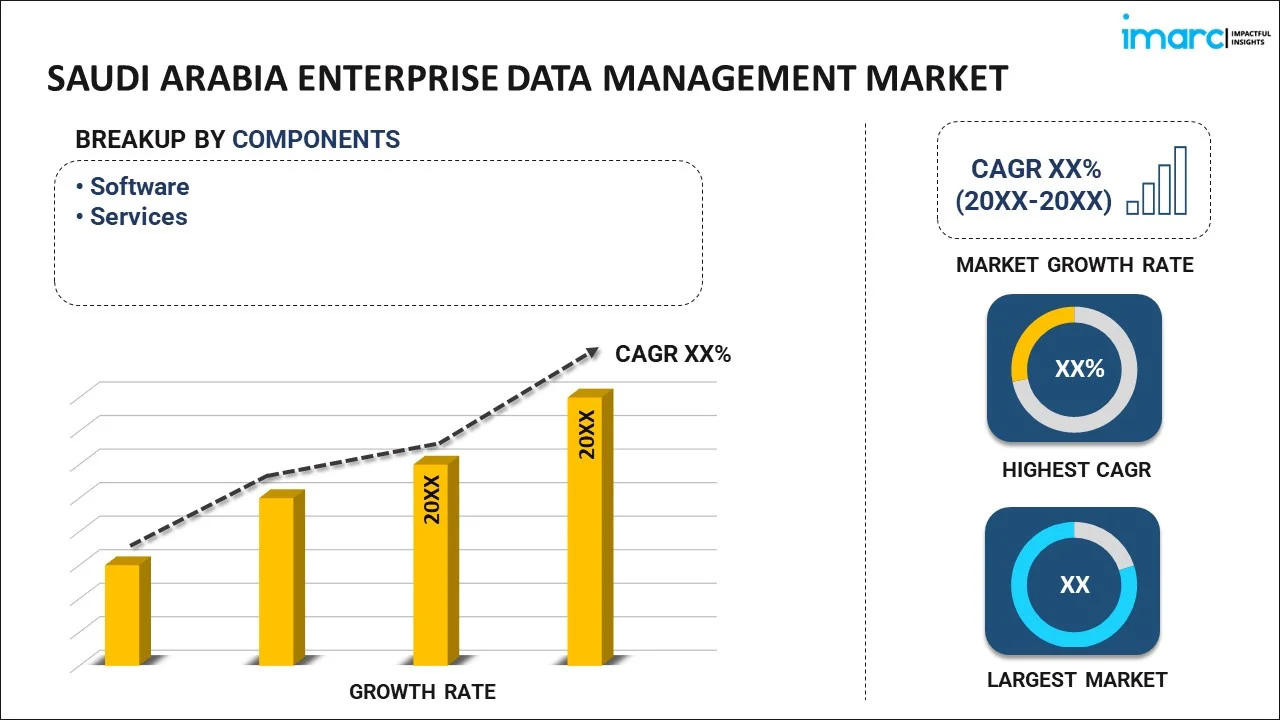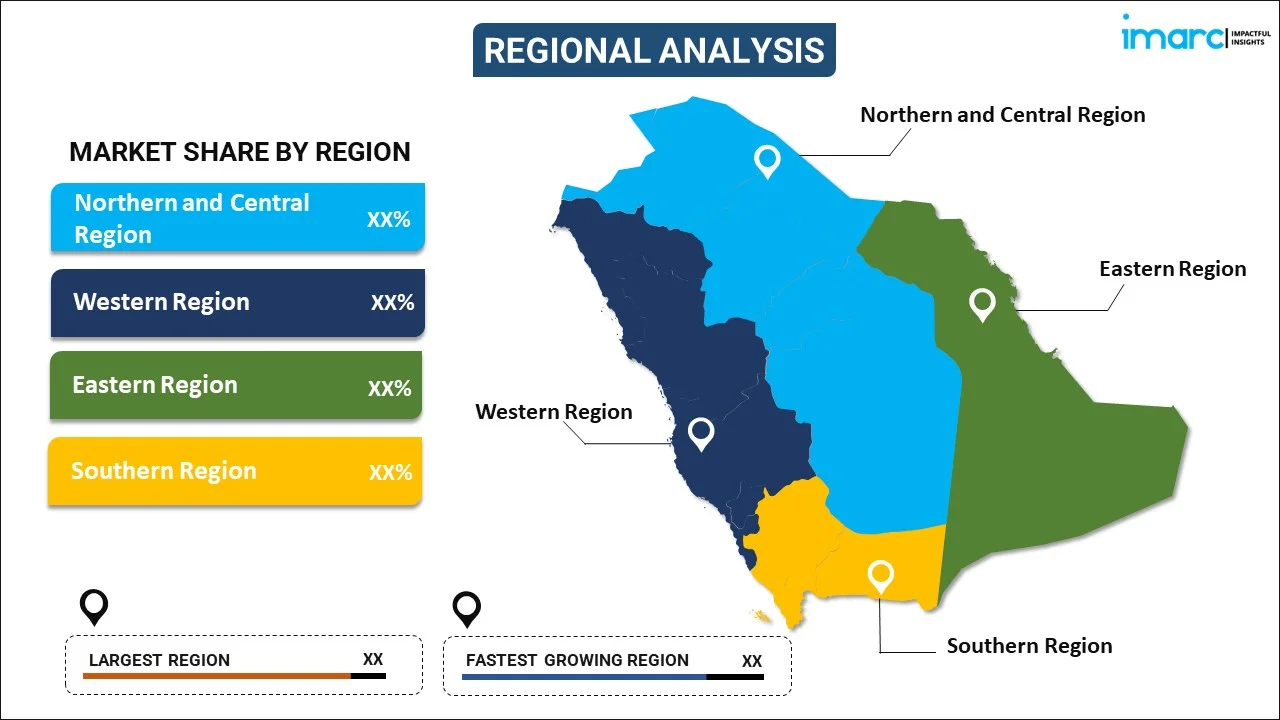
Saudi Arabia Enterprise Data Management Market Report by Component (Software, Services), Deployment (Cloud-based, On-premises), Enterprise Size (Small and Medium-sized Enterprises, Large Enterprises), Industries (IT and Telecom, Banking, Financial Services, and Insurance, Retail and Consumer Goods, Healthcare, Manufacturing, and Others), and Region 2025-2033
Market Overview:
Saudi Arabia enterprise data management market size reached USD 497.5 Million in 2024. Looking forward, IMARC Group expects the market to reach USD 1,357.7 Million by 2033, exhibiting a growth rate (CAGR) of 11.8% during 2025-2033. The integration of artificial intelligence and machine learning into business processes, which relies heavily on quality data, is driving the market.
|
Report Attribute
|
Key Statistics
|
|---|---|
|
Base Year
|
2024 |
|
Forecast Years
|
2025-2033
|
|
Historical Years
|
2019-2024
|
| Market Size in 2024 | USD 497.5 Million |
| Market Forecast in 2033 | USD 1,357.7 Million |
| Market Growth Rate (2025-2033) | 11.8% |
Enterprise data management (EDM) is a comprehensive approach that organizations adopt to efficiently handle and leverage their vast volumes of data. It encompasses the processes, policies, architecture, and tools used to collect, store, organize, and analyze data across the entire enterprise. EDM aims to ensure data accuracy, consistency, security, and accessibility, enabling informed decision-making and fostering a data-driven culture. Key components of EDM include data governance, data quality management, data integration, and metadata management. By implementing EDM practices, businesses can break down data silos, enhance collaboration, and derive valuable insights from their data assets. This strategic approach not only optimizes operational efficiency but also helps organizations comply with regulatory requirements and adapt to the rapidly evolving landscape of data technologies. Ultimately, EDM plays a pivotal role in transforming raw data into a valuable corporate asset, driving innovation and sustainable business growth.
Saudi Arabia Enterprise Data Management Market Trends:
The enterprise data management market in Saudi Arabia is experiencing robust growth driven by several key factors. Firstly, the exponential rise in data volume necessitates advanced EDM solutions to efficiently handle and process vast datasets. As organizations increasingly recognize the value of data as a strategic asset, the demand for comprehensive EDM solutions has surged. Moreover, the advent of cloud computing has significantly impacted the EDM landscape, fostering a shift towards cloud-based data management solutions. This transition not only enhances scalability but also facilitates seamless integration with other cloud-based services, driving market expansion. Furthermore, the growing emphasis on data governance and compliance mandates has become a pivotal driver for EDM adoption. Organizations are compelled to adhere to stringent data regulations, making robust data management solutions indispensable for ensuring compliance and mitigating risks. In addition to this, the proliferation of advanced analytics and artificial intelligence applications has heightened the need for high-quality, well-managed data. EDM plays a crucial role in providing a solid foundation for these technologies, contributing to their effectiveness and value realization. In summary, the EDM market in Saudi Arabia is propelled by the confluence of factors such as the data deluge, cloud adoption, regulatory requirements, and the burgeoning demand for advanced analytics, making it a dynamic and rapidly evolving sector.
Saudi Arabia Enterprise Data Management Market Segmentation:
IMARC Group provides an analysis of the key trends in each segment of the market, along with forecasts at the country level for 2025-2033. Our report has categorized the market based on component, deployment, enterprise size, and industries.
Component Insights:

- Software
- Data Security
- Master Data Management
- Data Integration
- Data Migration
- Data Warehousing
- Data Governance
- Data Quality
- Others
- Services
- Managed Services
- Professional Services
The report has provided a detailed breakup and analysis of the market based on the component. This includes software (data security, master data management, data integration, data migration, data warehousing, data governance, data quality, and others) and services (managed services and professional services).
Deployment Insights:
- Cloud-based
- On-premises
A detailed breakup and analysis of the market based on the deployment have also been provided in the report. This includes cloud-based and on-premises.
Enterprise Size Insights:
- Small and Medium-sized Enterprises
- Large Enterprises
The report has provided a detailed breakup and analysis of the market based on the enterprise size. This includes small and medium-sized enterprises and large enterprises.
Industries Insights:
- IT and Telecom
- Banking, Financial Services, and Insurance
- Retail and Consumer Goods
- Healthcare
- Manufacturing
- Others
A detailed breakup and analysis of the market based on the industries have also been provided in the report. This includes IT and telecom, banking, financial services, and insurance, retail and consumer goods, healthcare, manufacturing, and others.
Regional Insights:

- Northern and Central Region
- Western Region
- Eastern Region
- Southern Region
The report has also provided a comprehensive analysis of all the major regional markets, which include Northern and Central Region, Western Region, Eastern Region, Southern Region.
Competitive Landscape:
The market research report has also provided a comprehensive analysis of the competitive landscape. Competitive analysis such as market structure, key player positioning, top winning strategies, competitive dashboard, and company evaluation quadrant has been covered in the report. Also, detailed profiles of all major companies have been provided.
Saudi Arabia Enterprise Data Management Market Report Coverage:
| Report Features | Details |
|---|---|
| Base Year of the Analysis | 2024 |
| Historical Period | 2019-2024 |
| Forecast Period | 2025-2033 |
| Units | Million USD |
| Scope of the Report | Exploration of Historical and Forecast Trends, Industry Catalysts and Challenges, Segment-Wise Historical and Predictive Market Assessment:
|
| Components Covered |
|
| Deployments Covered | Cloud-based, On-premises |
| Enterprise Sizes Covered | Small and Medium-sized Enterprises, Large Enterprises |
| Industries Covered | IT and Telecom, Banking, Financial Services, and Insurance, Retail and Consumer Goods, Healthcare, Manufacturing, Others |
| Regions Covered | Northern and Central Region, Western Region, Eastern Region, Southern Region |
| Customization Scope | 10% Free Customization |
| Post-Sale Analyst Support | 10-12 Weeks |
| Delivery Format | PDF and Excel through Email (We can also provide the editable version of the report in PPT/Word format on special request) |
Key Questions Answered in This Report:
- How has the Saudi Arabia enterprise data management market performed so far and how will it perform in the coming years?
- What has been the impact of COVID-19 on the Saudi Arabia enterprise data management market?
- What is the breakup of the Saudi Arabia enterprise data management market on the basis of component?
- What is the breakup of the Saudi Arabia enterprise data management market on the basis of deployment?
- What is the breakup of the Saudi Arabia enterprise data management market on the basis of enterprise size?
- What is the breakup of the Saudi Arabia enterprise data management market on the basis of industries?
- What are the various stages in the value chain of the Saudi Arabia enterprise data management market?
- What are the key driving factors and challenges in the Saudi Arabia enterprise data management?
- What is the structure of the Saudi Arabia enterprise data management market and who are the key players?
- What is the degree of competition in the Saudi Arabia enterprise data management market?
Key Benefits for Stakeholders:
- IMARC’s industry report offers a comprehensive quantitative analysis of various market segments, historical and current market trends, market forecasts, and dynamics of the Saudi Arabia enterprise data management market from 2019-2033.
- The research report provides the latest information on the market drivers, challenges, and opportunities in the Saudi Arabia enterprise data management market.
- Porter's five forces analysis assist stakeholders in assessing the impact of new entrants, competitive rivalry, supplier power, buyer power, and the threat of substitution. It helps stakeholders to analyze the level of competition within the Saudi Arabia enterprise data management industry and its attractiveness.
- Competitive landscape allows stakeholders to understand their competitive environment and provides an insight into the current positions of key players in the market.
Need more help?
- Speak to our experienced analysts for insights on the current market scenarios.
- Include additional segments and countries to customize the report as per your requirement.
- Gain an unparalleled competitive advantage in your domain by understanding how to utilize the report and positively impacting your operations and revenue.
- For further assistance, please connect with our analysts.
 Inquire Before Buying
Inquire Before Buying
 Speak to an Analyst
Speak to an Analyst
 Request Brochure
Request Brochure
 Request Customization
Request Customization




.webp)




.webp)












